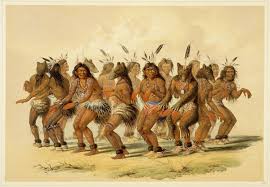
To many people the understanding of Indigenous traditions are a mystery. In some contexts, they have been misunderstood, in others they have been ignored as pagan, or devil worship. Yet, both of these would be wrong in concerns to today’s native expression.
The native peoples of the Americans (North, Central and South) all have many things in common and one of those is the centrality of the dance. Seen as a means of prayer, the dancer was the one who prayed for the universe to Monto’ac, or Great Mystery. Every person has a role in native society and the dancer was at the forefront of prayer. Depending on the tribe, every native knew how to dance to some degree, even if it was basic dancing. Warriors knew how to dance the dance of the warrior, the hunter the dance of the bow, the holy man, or healer, also had several dances that he, or she, would do. It is very hard to lump all tribes into one synthesis. Instead, I would like to introduce you to the Croatan people, their understandings, their dance and worship.
The Croatan people are the ancient ancestors of North Carolina and Upper South Carolina in the Dillon County/Marlboro County area. These Indians were apart of a much larger group of tribes, each tribal unit had a Werowance that worked as a chief of each tribe. The name Croatan refers to the central village that these Werowances would meet in order to trade, politicize and fight off enemies. In this these tribes were unified in a common language, culture and tradition, the Algonquin tradition.
Dancing was central to the Croatan worship. An eternal flame would be kept inside of a temple that was offered to Ahone, the great God of the Croatan people. A Priest watched over the fire and there was a group of priests in Croatan village that would work to heal the people and provide religious ceremonies. It is said that when twelve priests would gather in one spot, Ahone would make himself known, give them guidance and teach the Priests. Such teachings would lead to the convergence of many Croatan to the Anglican faith. Many of these are still members of the Methodist Church. Dancers would get dressed up in ceremonial garb and would dance around the eternal flame when prayers were needed. These dancers represented the people and they would dance while the priest prayed and made the offering of tobacco.
Before each hunt, battle, entrance into the temple, or dance, the people were incensed by the priests in training with sage, a very important herb to the Croatan people. While many Croatan today have given up many of these things due to assimilation, these are many things that are inculturations of our mission. It is with great hope that we will be able to help the people we work with to continue the dance so that the prayers of the people will be offered to God. I hope this has helped you understand the importance of the dance. If you see an Indian dancing in the morning, know that he has taken this sacred charge of being a dancer, a prayer warrior for his people. Give him honor, and tobacco, that he might pray for you and that the prayers of the people might be answered.
